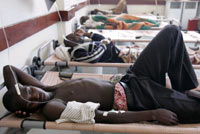Zimbabwe
Cholera death toll hits 565
Article published on the 2008-12-02 Latest update 2008-12-03 10:02 TU
The death toll from cholera in Zimbabwe rose to 565 on Wednesday, according to the UN's health organisation, with 12,546 cases of the acute intestinal disease reported nationwide. The capital Harare is the worst-affected area with 177 deaths and 6,448 suspected cases.
The government cut the water supply in order to stop the spread of the disease, but experts fear that lack of water, especially in urban areas, will exacerbate the situation.
"The main problem we have right now is that the mobilisation of people [leaving the capital] is making it extremely complicated to contain the epidemic," says Alex Le Cuziat, the head of mission for aid group Action Against Hunger in Harare.
Cholera has been reported in nine out of 10 provinces throughout the country, with the highest numbers in urban areas, especially the capital.
"Obviously Zimbabwe has a good road network, so people are traveling quite a bit. Now we have cases spreading all around the country, especially towards the south and south-east, towards the bottom of Mozambique," Le Cuziat told RFI.
Interview: Alex Le Cuziat, head of mission for Action Against Hunger in Harare
Unicef reports that there are outbreaks over the border in the South African town in Messina and in Botswana, as well.
The aid agencies are scrambling to try and contain the disease, which has affected upwards of 10,000 countrywide.
Our correspondent in Zimbabwe Ryan Truscott reports that water is back on in the business district of the capital and in a few suburbs, but is trickling out at very low pressure.
"It makes it greatly difficult for the aid agencies who are not normally built on providing infrastructure support," said Bob McCarthy, Unicef's regional advisor for humanitarian assistance.
The relief organisations operating in the country have been distributing water purification kits, and Unicef has been providing 360,000 litres of water per day, along with other aid agencies.
Action Against Hunger has been providing people throughout the country water in bladders, and is looking at means to truck water throughout the country.
"We are calling on people to wash their hands and are providing emergency latrines. We're cleaning up human waste and whatever we can do in terms of sewage," says Le Cuziat.
The waterborne disease is easily spread through personal contact, including shaking hands with others.
The water may be back on, but water cuts in Zimbabwe have been a part of daily life for the past six months, says Le Cuziat.
"People need safe drinking water, and they are going to look at alternate sources," said McCarthy. "We know the alternate source options are very poor. What we are trying to do with our partners is to purify the sources that are there."
According to state media, the Zimbabwe National Water Authority (Zinwa) failed to find chemicals to treat the water supply.
"Unfortunately this outbreak is the most visible symptom of collapsed social services in the country," said McCarthy. "In this kind of situation, children are the most vulnerable."
Interview: Bob McCarthy, Unicef regional advisor for humanitarian assistance, Nairobi








